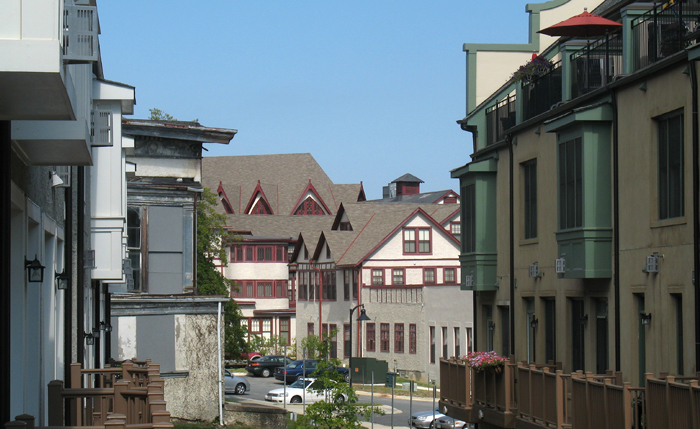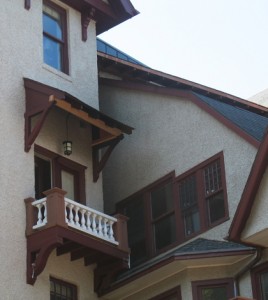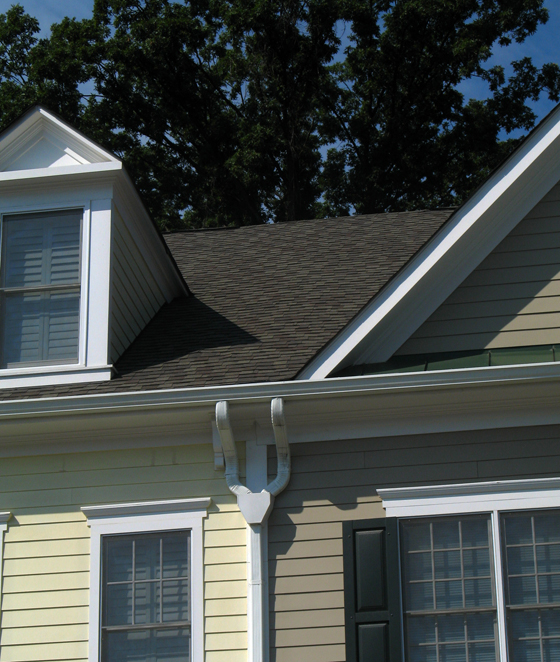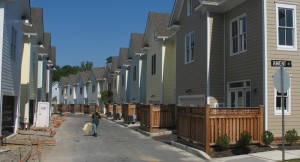
But from the enormous source material of the existing buildings, the Alexander Company took what opportunities it had and exploited them into a quiet celebration of the specific context. The original buildings, despite their conversion to a warren of private apartments and condominiums, have kept of their idiosyncrasies. In spite of sparkling new halogen lights and granite countertops, the apartments retain the unique elements that make the buildings meaningful to residents.

A handful of the walkways are now transformed into libraries, their walls covered in yards of books, branching and twisting out from the residences. Imagine the intrigue, the complexity, and the uniqueness such a feature adds to an apartment. Conventionally held in disdain as a characterless housing unit, the condo is transformed into a place by its form. Even on move-in day, welcoming neighbors who are curious to see what strange secrets are hidden in the suite. Think about how many people will remember that couple that had a tube full of books, was full of stained glass, or looked onto a 100-foot ballroom: how cool those apartments are.
Unintentionally and aside from the logic of the apartment’s design, community is already formed and begun by this curiosity, this icebreaker in the form of architecture and history is set to be the seed from which a good place is formed. Architecture as a profession cannot guarantee community or lifestyle, but if it can get people in a comfortable adjacency to talk, then that has already succeeded beyond its nominal aims of shelter and design. And the discussion will not end there: the apartments will be a continual source of wonder and pride, more so than simply the objects inside the house.
Looking for criteria for good architecture, the social hook is a strong. A rare source of connection between form and life, the characteristic works in another way as well: caring about the physical environment. Urban planning has, in recent years, focused on a sense of ownership or stakeholding in the locality to guarantee high-function communities. Crucial to this concept is a sense of pride in one’s own property – as well as a sense of quality and beauty with the surroundings. These are real places of distinct value, the nooks and corners easily gathering the dust of familiar memories.

That is not to say that the houses across the street won’t become dear to anyone. If a housing project can become dear to people through decoration and habitation, then any assemblage of rooms full of family can. Flaws arise from the implicit pretension of the design. Rather than simply having good and interesting designs, the architecture of these rowhouses (like many new towns) pretends that it has experienced these memories and that the windows have seen so many years. The slick presentation extends into EYA’s pamphlets. In gentle type, they refer to the suburban installation of their product as a “townhome.” Marketing. Marketing.
What the style of these buildings seeks to emulate is a natural, unassuming process of development that marries concern for the whole with concern for the individual component. The means by which it becomes natural is by having had multiple minds but a general desire for completeness and a casual respect for the extant structure. To care too little for the original structure and the new buildings will be incoherent and ugly, like the follies without the main building. Conversely, to care too much for the original and the extension will be subjugated and become a crude appendage that does not respond to new needs created by the expansion.
The architects of the National Park Seminary, like planners in any living city, embraced the existing form while pushing their vision onto the old structure. The complexity that enthralls viewers in its inexplicable flow results from the desire to compensate without settling. In order to get from one style to another, to change functions between columns, the designers used middle forms that just came as a consequence from the situation. The intermediate elements and the compensations are the parts that seem to make the building the most interesting, the most unique.
The refinement of the National Park Seminary complex arises from the many people who have had their hands in the process of design and adjustment. The design of each building grew out of several different intentions, in sequence. Like a chain story, intentions become lost, with only the buildings remaining to express information. Without a master plan, changes become totally responsive to the newer conditions and ideologies, the designers adapt to the context complementing what is already there.

Tradition, in a literal sense, means “things handed over.” While many associate tradition with aesthetic systems, anything that develops along a braid of time and people is a tradition. An unplanned town is a tradition. Forest Glen Seminary is a manifest tradition. Instead of a cultural practice, the building itself passes from one generation to the other, with tweaks and refinements resulting in sophistication. Physical structures that are traditional, not merely built with traditional styles or techniques, display emergent properties that prove extremely difficult to replicate through simple design.

But EYA wanted to replicate the look and feel of the old seminary buildings. They tried in the easiest way possible, by using some similar styles in similar ways, surely thinking that emulating the older forms would result in unassuming and respectful neighbors. But they don’t feel like that. Whether dull or overpowering, they lack those essential characteristics, such as middle-forms, inflection, and awkward harmony that make Forest Glen what it is. They lack that collaborative, emergent design process.
To reiterate: it looks to the past to look like the past, but never looks at the past. Tradition, critically applied, renders enduring beauty, but left to a simple appliqué, it degenerates to a blind insistence on the image of an idea. This particular image is a bare interpretation of an organic structure, one that perceives style as masquerade, rather than the involuntary, consequential expression of a greater architecture. The rowhouses share more in common with the follies – stylistic exercises that attempt to “culture” the neighborhood through a simplistic projection of context.
But the beauty of Forest Glen has never been its stylistic character; it has been the architecture that syncretized the buildings. The pagoda and the windmill are still fun, yet their mystery does not last, compared to the multidimensional complexity of the main building’s design. The context of the follies is simply not deep and not full of place. To address the context of the National Park Seminary, a designer would need to apply fundamental aspects of the vernacular architecture that ably absorbed multiple fashions into a classic whole.

Part 1: Into the Woods;
Part 2: One Thing Leads to Another;
Part 4: Back to the City Coming Soon!
3 thoughts on “Forest Glen Seminary: An Unintentional Project”